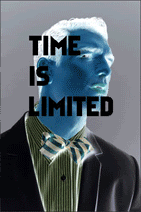
Maila Nurmi (born in 1922 in what is now Pechenga, Russia) was at various points in her life a model, an actress, a chorus-line dancer, a hat-check girl, an Emmy-nominated TV hostess, a linoleum installation worker, a carpenter, and Goth icon. She also dated Orson Welles for a few months, was friends with James Dean (who was disappointed to discover that she was not a satanist), and rubbed elbows with Elvis Presley and Marilyn Monroe. She is best known, however, for her role in what is commonly referred to as the worst movie ever filmed:
Plan 9 from Outer Space.
Nurmi grew up in Ohio, but split for LA in 1939. There, she supported herself through the odd modeling jobs and posing for pin-ups (working at one point with surrealist photographer Man Ray) trying to make her big break into Hollywood. Despite a few bit parts, fame eluded Nurmi. She did get acquainted with several notable celebrities, and met and married Oscar-winning director and screenwriter Dean Riesner.

In 1953, she attended a costume ball in a get-up inspired by Morticia from Charles Addams' famous New Yorker cartoon series. Clad in a black dress, and wearing pale make-up, Nurmi looked like a walking corpse. She was spotted by KABC-TV producer Hunt Stromberg Jr., who realized that she'd be perfect to host various horror and science-fiction films being aired on his station. Nurmi's husband concocted the name "Vampira" and the character was born. One year later
The Vampira Show (originally titled "
Dig Me Later, Vampira") debuted. On the show, Nurmi would introduce various films in a gothic set obscured by generous amounts of artificial fog. Accompanied by a puppet spider named Rollo, Vampira would typically unleash a series of deliriously bad graveyard-themed puns. The show was a smash hit, and Nurmi's fame grew.
Life magazine published an article about the show and the Vampira character, while Nurmi ran for mayor of Hollywood as Vampira for a promotional stunt. The show's format proved so successful that various television studios across the nation began mimicking it, airing Universal Studios horror movies that had been leased in a package deal. All sorts of campy, ghoulish hosts were created and the era of Creature Feature television had begun.
After surviving a bizarre murder attempt in 1955, in which a lunatic invaded her home and held her hostage for four hours until she escaped, Nurmi again tried to segue into the film industry. She was contacted by infamous schlock director Ed Wood and was offered a role in his film
Plan 9 from Outer Space. Hoping to use it as a stepping stone to better things, Nurmi accepted. The movie was legendarily awful and Nurmi's subsequent roles were in movies equally bad or worse, such as
Sex Kittens go to College. Decades later, these films would be featured on late-night TV shows similar to one she had pioneered.
By the time the sixties had rolled around, Nurmi could scarcely find work in Hollywood and her relationship with Riesner had dissolved. They were divorced, and Nurmi later re-married to actor Fabrizio Mioni. To earn money, she fell back on oddjobs, and later opened an antiques store called Vampira's Attic that sold items to (among other people) the Zappa family. She operated the store until 1981, in which an aborted attempt was made to resurrect the Vampira Show. Nurmi was unhappy with her lack of control over the show and departed, taking with her the Vampira name and likeness. The result was the Vampira-clone
Elvira,
Mistress of the Dark, portrayed by Cassandra Peterson. Nurmi sued, claiming that Elvira was infringed upon the Vampira likeness, but lost the case. Elvira went on to become an iconic-figure in 1980's pop-culture. Vampira, meanwhile, was immortalized in a song of the same name by punk group
The Misfits.
Nurmi did get some recognition after the arrival of home video introduced Vampira to new audiences.
Plan 9 From Outer Space had suddenly become a mega-hit thanks to its unparalleled ineptitude, and Nurmi was receiving interview offers by horror magazines and documentary filmmakers. In 1994, Tim Burton famously directed a heavily-exaggerated biography of Ed Wood, and Nurmi was portrayed by model Lisa Marie. It was that same year that a Vampira model kit was unveiled, along with other merchandise. Images of Vampira, particularly those taken from
Plan 9 from Outer Space, were appropriated by the Goth sub-culture and Nurmi gained further fame amongst this group. She eventually began operating a website through which she sold autographed Vampira memorabilia. Nurmi died in Hollywood in 2008 at the age of 85. She was given a brief tribute at the 2009 Academy Awards.
Would you like to know more?
-
The Official Vampira website-
Maila Nurmi's filmography
 Hell, as described by Tundale, is not truly a place, but rather a living thing attended to by the Devil. Those who fall to Hell are lead to the monster Acheron, a giant with three gigantic throats and a mouth large enough to swallow nine thousand men. Acheron devours all who are thrown to him, and they fall into his enormous pit-like stomach. Sinners are left in torment, forever sealed in darkness as they are eternally digested amidst screeching monsters and wild animals, similarly trapped. Upon witnessesing such horror, Tundale returned to life a god-fearing, church-going man.
Hell, as described by Tundale, is not truly a place, but rather a living thing attended to by the Devil. Those who fall to Hell are lead to the monster Acheron, a giant with three gigantic throats and a mouth large enough to swallow nine thousand men. Acheron devours all who are thrown to him, and they fall into his enormous pit-like stomach. Sinners are left in torment, forever sealed in darkness as they are eternally digested amidst screeching monsters and wild animals, similarly trapped. Upon witnessesing such horror, Tundale returned to life a god-fearing, church-going man.






















